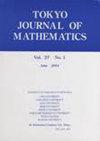多个超几何欧拉数的几个性质
IF 0.4
4区 数学
Q4 MATHEMATICS
引用次数: 3
摘要
本文引入了高阶超几何欧拉数,并给出了几个有趣的表达式。1875年,格莱舍给出了数的几个有趣的行列式,包括伯努利数、柯西数和欧拉数。包括伯努利、柯西和欧拉超几何数在内的超几何数的一个优点是它们的行列式的自然扩展。作为应用,我们可以得到欧拉数是行列式元素的逆关系。本文章由计算机程序翻译,如有差异,请以英文原文为准。
Several Properties of Multiple Hypergeometric Euler Numbers
In this paper, we introduce the higher order hypergeometric Euler numbers and show several interesting expressions. In 1875, Glaisher gave several interesting determinant expressions of numbers, including Bernoulli, Cauchy and Euler numbers. One advantage of hypergeometric numbers, including Bernoulli, Cauchy and Euler hypergeometric numbers, is the natural extension of determinant expressions of the numbers. As applications, we can get the inversion relations such that Euler numbers are elements in the determinant.
求助全文
通过发布文献求助,成功后即可免费获取论文全文。
去求助
来源期刊

Tokyo Journal of Mathematics
MATHEMATICS-
CiteScore
0.70
自引率
16.70%
发文量
27
审稿时长
>12 weeks
期刊介绍:
The Tokyo Journal of Mathematics was founded in 1978 with the financial support of six institutions in the Tokyo area: Gakushuin University, Keio University, Sophia University, Tokyo Metropolitan University, Tsuda College, and Waseda University. In 2000 Chuo University and Meiji University, in 2005 Tokai University, and in 2013 Tokyo University of Science, joined as supporting institutions.
 求助内容:
求助内容: 应助结果提醒方式:
应助结果提醒方式:


